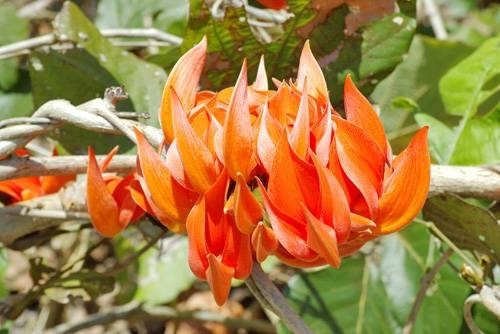Butea superba
Butea superba, also called Plossobaum, is a plant species in the subfamily of the Fabaceae ( Faboideae ) within the legume family ( Fabaceae ). It is native to southern Asia and Southeast Asia and is used as a medicinal plant. The specific epithet superba, Latin for proud, stately, refers to the magnificent flowers. Trivial names in the home countries are Chhola -Ki- Bel (Hindi ), Chihunt (Hindi ), Climbing Palas (English), Lata Palas (Hindi ).
Description
Butea superba grows as a vine, reaching stature heights of up to 12 meters. The pinnate leaves consist of obovate - rhombic leaflets that are 12-30 cm long and 10-27 cm wide.
Butea superba is racemose inflorescences. The flowers are zygomorphic. The yellowish- orange petals are 4-6 cm long and hairy The shallow, 13 to 15 cm long and 2.5 to 5.5 cm wide legumes contain an egg-shaped, flattened seeds.
Dissemination
The natural range of Butea superba ranges from Sri Lanka, India, Laos, Myanmar, about Thailand, Cambodia, China and Vietnam and from Java to the Philippines.
In India it is found in Andhra Pradesh, Bihar, Dadra - Nagar Haveli, Goa, Gujarat, Karnataka, Madhaya Pradesh, Maharashtra, Orissa, Rajasthan, Tamil Nadu, Uttar Pradesh, West Bengal. It is distributed in the forests of the northern and eastern regions of Thailand and along Kanchanaburi Province. In Mauritius, it is a neophyte.
Taxonomy
Butea superba Roxb synonyms for. are Plaso superba ( Willd.) Kuntze and Rudolphia superba ( Willd.) Poir ..
Use
Locals claim that Butea superba have a potency- enhancing effect. Butea superba is widespread in the forests of Thailand and enjoys because of the alleged rejuvenation effect and increasing libido great popularity among Thai men.
The tuberous roots of Butea superba contain flavonoids and flavonoid glycosides and sterol including β -sitosterol, campesterol and stigmasterol.




.jpg)





